MV Agusta F3 800 First Ride Review
MV Agusta F3 800 First Ride Review
It had to happen, sooner or later. After the acclaim accorded to the punchier, torquier, 798cc long-stroke version of MV Agusta’s 675cc three-cylinder F3 engine in the 800 Brutale naked bike, the Italian company has now followed this up with an F3 800 sportbike version. And it’s already in production.
After riding the new bike for a full day at the Misano GP circuit under Italian sunshine, there’s only one conclusion to be made: this new bike is truly the best of both worlds, combining the slim build, nimble handling and appetite for revs of a 600cc Supersport, with the torque and rideability of a 1200cc V-twin.
To create it, MV’s R&D team headed by its Direttore Tecnico, Marco Cassinelli, has developed an uprated version of the 800 Brutale motor, similarly obtained by increasing the stroke from its F3 675 sister bike’s 45.9 mm to 54.3 mm, while the bore size remains unaltered at 79mm. This has increased engine performance by 20 hp, or 15 percent, to a peak of 148 hp/108.8kW at 13,000 rpm, with maximum torque of 88Nm/8.97kgm delivered at 10,600 rpm – a 10 percent step up from the 800 Brutale’s and produced 2000 rpm lower.
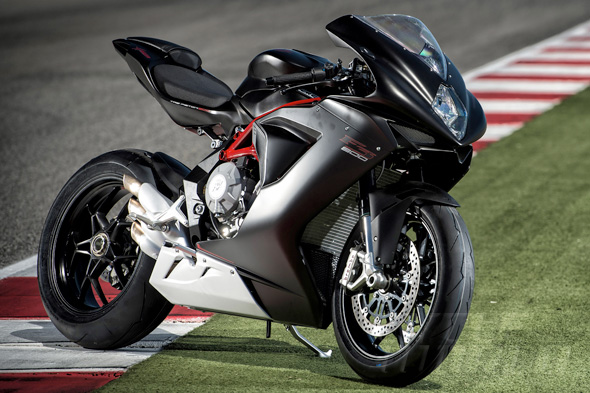
The rev-limit has been reduced to 13,500 rpm from the F3 675’s 15,000 rpm redline, but in weighing exactly the same at 381 pounds, it results in a huge step up in the power-to-weight ratio of 13.5 percent that allows MV’s latest and greatest to compete on overall performance terms with bigger-engined, more potent, but heavier and less agile one-liter Superbikes.
It also gets the slipper clutch that’s missing from the F3 675, and MV claims a homologated top speed of 167 mph for the new bike – 10 mph up on the smaller model, obtained via a longer final drive ratio raised from 16/43T to 17/39T.
To achieve this lift in output, MV has fitted the same cylinder head as the F3 675, with titanium valves all around (the 800 Brutale has steel valves), while the three 50mm Mikuni throttle bodies each now carry twin injectors, same as on the smaller F3.
- Published in Motorcycle Review
MV Agusta Brutale Corsa- First Look Review
MV Agusta Brutale Corsa- First Look Review
Now that MV Agusta has introduced the 800cc version of its compact Triple, the R&D department can get back to work on the larger-displacement four-cylinder models. First up is a hotter, more refined version of the top-of-the-line Brutale RR.
The Brutale Corsa is powered by the Brutale RR’s liquid-cooled, dohc, 16-valve, 1090cc inline-Four. Claimed output (158 horsepower at 11,900 rpm and 73.75 foot-pounds of torque at 10,100 rpm) is the same as that of the RR, but everything else has been updated.
An Öhlins 43mm NIX fork is standard, along with lightweight forged aluminum wheels, radial-mount Brembo Monobloc calipers pinching 320mm discs and a fully adjustable Sachs shock. Brake and clutch controls, as well as the related reservoir caps, and the rider’s footpegs, are machined from billet.
A hand-sewn seat and carbon-fiber fenders/license-plate holder give a touch of exclusivity to MV’s newest naked model. The graphics are also exclusive: a glossy black frame and a two-tone Pearl White/Pearl Red paint.
Price in Italy for the MV Agusta Brutale Corsa is 20,990 euros or $26,989 at current exchange rates.
- Published in Motorcycle Review
2013 BMW R1200GS Review
2013 BMW R1200GS Review
So here we are in South Africa, among the first in the world to ride the fifth generation of the A-T class icon. BMW’s goals for the new GS were improved performance, both off-road and on, plus enhanced safety and comfort.
“It was time to strike out on a new path,” said Hermann Bohrer, VP BMW Motorrad plant Berlin, at the bike’s launch. “We’re resetting the counter to zero.”
And by “zero,” BMW means this new GS shares virtually nothing with its predecessor.
Boxer Punching Above Its Weight
The key component to the new GS is a completely redesigned horizontally opposed Twin. BMW threw out everything except the engine’s bore and stroke, thus it retains the 1170cc displacement we’ve become familiar with over the past nine years. The revitalized Boxer will be making its way into other R-series Beemers, likely first into a reworked R1200RT within a year.
The previous Boxer motor used a blend of air and oil cooling, with air providing the bulk of the cooling (78%), augmented by heat transfer from oil for the remaining 22%. The engine in the new GS is being termed “liquid-cooled,” but 65% of the heat it sheds is still accomplished by air flowing over the engine’s remaining cylinder fins. Due to the retention of significant air cooling, the liquid-cooling of the new Boxer (two small radiators, coolant, hoses, fan) is purported to add just 6 pounds over the old air/oil-cooled mill.
The new Boxer’s cylinder heads also receive the benefits of a clean-sheet redesign. Instead of receiving air and fuel horizontally from behind the heads, the intake mixture is now sent via a “vertical through-flow” system, basically a full down-draft arrangement, for greater performance and efficiency. It also frees up foot space where the throttle bodies were previously located. Intake and exhaust valve diameters are up 1mm for more effective flow, and exhaust gases are now dumped from the bottom of the cylinder head.
Due to a narrow angle between the intake and exhaust valves, the more efficient combustion chamber allows compression to be bumped half a point to 12.5:1. Like Ducati’s Panigale, the new GS has an automatic decompression feature that allows a smaller starter and battery for less weight. Also new to the Boxer is E-gas, more commonly known as a ride-by-wire throttle. This advancement enables five programmed riding modes and cruise control for the first time in GS history.
The net result is a 15-horsepower boost, now pumping out a claimed 125 hp at 7700 rpm. Torque is also up, churning out a peak of 92.2 ft-lb at 6500 rpm, up from 89 ft-lb at 6000 revs. The new Boxer’s rev ceiling is lifted 500 revs to 9000 rpm.
Africa-By-Wire
Although many adventure bike owners don’t travel far off the beaten path, BMW’s GS has an enviable off-road reputation that has been integral to building the brand. To test out the full complement of GS chops, journalists were flown halfway around the world to exotic South Africa where traffic enforcement is lax and unpaved roads are abundant.
First impressions of the Berlin-built machine are strongly positive. The new GS looks great in the flesh, boasting a more contemporary and edgier appearance. An LED main headlight is said to be the first ever installed on a motorcycle. New LED turnsignals are tiny and must be the smallest OEM signals ever. Fingers wrap over new levers, one of them nylon, and both adjust over a large range via a new mechanism.
A slimmer midsection allows legs a more direct path to the ground from its 33.5-inch perch, its lowest position. Those needing more legroom can flip the seat’s adjustable mounts to yield a height of 34.3 inches. The seat’s angle can also be changed, although I’m not sure why any male rider would want a saddle that slopes into the back of the fuel tank. Optional is a low seat that drops heights to 32.3 or 33.1 inches.
The new Boxer fires up almost instantaneously and much quicker than last year’s model, settling in to a familiar horizontally opposed Twin cadence. A squeeze of the clutch lever reveals an incredibly light pull thanks to a mechanical assist function and an oil-bathed multi-plate unit that replaces the dry, single-plate clutch in the previous model that could overheat when bogged down to a crawl. Clutch maintenance is dramatically simplified by locating the clutch, now with a slipper function, at the front of the engine behind an exposed access panel. The clutch’s narrower engagement zone combined with less flywheel effect from the engine makes the bike slightly more difficult to tractor away from a stop than previous.
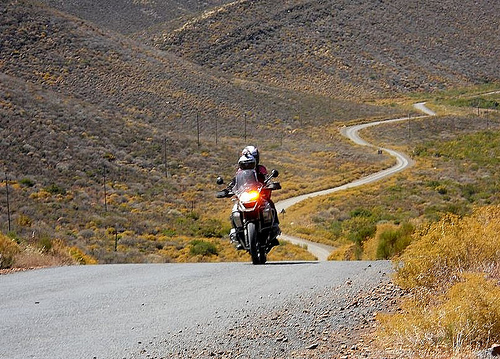
The clutch formerly resided between the engine and transmission, requiring removal of the tranny for replacement. But the unit-construction powertrain of the new GS means the gearbox no longer bolts on as a separate component. The result is a dramatically shorter engine front to rear, enabling a 53mm longer Paralever swingarm inside a 59.3-inch wheelbase identical to the old version.
The smooth engagement of first gear is a sign of good things to come. While the R1200’s old gearbox required long throws and considerable clunkiness, this new tranny shifts with remarkable slickness. Its only drawback is a neutral position that is sometimes difficult to toggle to while wearing off-road boots.
The torque curve from the previous R1200 lump was enviably flat, able to provide strong thrust at nearly every rpm. This new engine has a similar powerband, but it feels punchier throughout. One can tell a lot about the power of an engine by how easily it will pull a wheelie, and the swiftness at which the GS’s front wheel lifts off (when TC is disabled) with a bit of clutch in second gear demonstrates the new motor’s improved stonk. Enhancing the visceral riding experience is a newfound honk from the engine’s intake now located between and ahead of your knees. Their higher location also enables fjording deeper water crossings.
The E-gas R-b-W system is well sorted and doesn’t suffer a disconnected feel. Throttle response depends on which riding mode is selected. The Dynamic mode is snappiest, while Rain mode is at the other end of the spectrum. However, peak power is said to be supplied in every mode, and even the Rain setting didn’t feel overly neutered.
The GS uses a completely new steel frame to work with the new engine, but the bike’s key chassis geometry (rake, trail and wheelbase) is basically unaltered. As such, the fresh GS feels a lot like the old GS. Its curb weight has risen 21 pounds to 525 pounds, but it doesn’t feel any heavier.
There’s now more rubber on the road or trail. A 120/70-19 up front replaces the previous 110mm-section tire, while the rear (170/60-17) is 20mm wider. Cast aluminum wheels are standard equipment, but the optional spoke wheels of our test bikes are more rugged and better suited to serious off-road use.
Antilock braking is included with every new BMW, and the GS is no different. But what’s new is a pair of radial-mount Brembo calipers on the front wheel and a slightly larger brake rotor (276mm) out back. The front brakes feel sharp on the street, but they’re so easy to modulate via steel-braided lines that they also work well off-road, offering excellent sensitivity.
New ABS programming results in an improved system, with its parameters based on the chosen riding mode. Braking is “Integrated” in BMW-speak, which means the front and rear brakes are linked, again with settings based on ride modes. Two-wheel purists may hate the integrated-brake concept, but they have little to fear about its transparent operation in the GS. This is a terrific set of binders. ABS can be switched off if desired.
Suspension duties are again handled by a Telelever front end and a Paralever rear that incorporates the driveshaft. However, the Tele is a new design, and the EVO Paralever now swaps sides with the muffler. BMW claims they, together with the new frame, provide a significant increase in torsional stiffness.
The standard GS is equipped with a non-adjustable shock inside the Telelever, while the rear damper is adjustable for preload and rebound damping. But we didn’t test it.
Instead, we rode on bikes equipped with optional Dynamic ESA, a semi-active suspension system with roots first seen in BMW’s HP4 version of the S1000RR sportbike. A similar system is also featured in Ducati’s latest Multistrada. Spring-travel sensors relate data to a computer that electronically alters damping control based on riding conditions and the ride mode chosen. Inside each ride mode, the suspension can be set to hard or soft options.
Dynamic ESA performed well on the pavement, offering a fairly supple ride while maintaining enviable wheel control. BMW’s Telelever again proved its efficacy by limiting front-end dive under braking, something with which many long-travel adventure bikes struggle.
After some enjoyable paved roads, it was time to ascertain the GS’s off-road capability on a twisty gravel/dirt road. Switching to Enduro mode on the fly, the Gelande Strasse adapted itself to the loose conditions. I was pleasantly surprised at the considerable rear-wheel drifting the ASC allowed, letting a rider hang it out a bit while maintaining the security of a TC safety net. And the bike’s fatter tires didn’t seem to reduce effectiveness off-road.
Aiding tire grip is one of the most tractable engines ever placed in a motorcycle. The new Boxer is remarkably flexible, able to chug ahead cleanly from just 1500 rpm. Speeds on this road varied from 10 mph to 75 mph, but I kept the transmission in third gear the entire time while still maintaining a brisk pace. Traction was enhanced in slow corners by low revs, putting down its power confidently, and higher-speed sections were devoured by the extra surge of power at 6500 rpm.
Later in the day we sampled a GS set up for off-road work, including a one-piece (and taller) enduro seat, crash bars and an optional jumper wire that allows access to the Enduro Pro mode that offers sharper throttle response and allows more front-wheel lift before TC intervenes. As with the other modes, you’ll have to switch off the ASC to enjoy proper wheelies. Another benefit of Pro mode is that it automatically saves all your last settings (for example, ABS and TC switched off) and remembers them when re-starting; default settings are resumed when in the other ride modes.
The GS’s off-road behavior won’t surprise anyone who’s ridden previous versions. It’s still monstrous for anything resembling a dirt bike, but it’s shocking how well it can navigate tricky sections if you’re careful and maintain some momentum. Keep up your speed and it barges through almost any obstacle like a two-wheeled Panzer.
New for ’13 is a thicker aluminum handlebar that is placed just right for street adventures but is too low for riding while standing. However, the bar can be rotated forward in its clamps to yield a height nearly an inch taller. Rubber peg inserts quell vibration on road, and they compress under a rider’s weight when standing to offer feet a solid purchase on the pegs’ serrated edges.
Back on paved roads, the GS proves its mettle as a capable sport-tourer. A key improvement to its street manners is a larger windshield that now can be adjusted over a wide range of height and rake via a hand knob that can be spun while riding. It delivers exemplary protection when in its uppermost position and is said to be a significant 5 decibels quieter than the old screen (that could be only adjusted when the bike was stopped) at 110 mph.
As for the lofty velocity that few of you outside Germany or South Africa will enjoy, the invigorated GS proved to have no difficulty cruising at that speed. In fact, I saw 145 mph on the analog speedo more than once on our ride.
Sluicing through a canyon road is entertaining on the GS, able to be hustled at a hurried pace that could embarrass more than a few sportbike jockeys. The wide handlebar provides plenty of leverage to quickly bank into a corner, and the new suspension keeps the chassis on an even keel. Rider-friendly engine response, even in Dynamic mode, makes optimum use of available power. Gearshifts are swiftly dispatched, and the new slipper clutch proves to be surprisingly useful on an A-T bike when ridden like a sportbike.
As you can tell from what’s written above, we’re astonished with what BMW has done to comprehensively upgrade nearly every aspect of a bike that was already the class standard. The new GS is able and quite willing to tackle nearly every duty that could be thrown at it, from navigating Jeep trails to swiftly sailing to far-off destinations to a commute to work.
However, the GS did disappoint me during a casual ride down an open dirt road. I was standing up to get cool air through my riding gear, traveling about 45 mph, when I encountered a washboard section. In an instant and with seemingly no provocation, the bike went into a wild tankslapper that threatened to throw me from the bike. It was a very panicked second before the steering regained its composure.
We can’t yet say for certain this is a problem with the bike, but another journalist reported a similar experience when he was riding while standing. This is quite unexpected considering the chassis geometry is essentially unchanged from the previous model, plus there were no stability issues whatsoever during high-speed road riding. I wonder if perhaps the Dynamic ESA allowed the front suspension to pack down over the washboard surface, reducing its rake and trail to less stable geometry. Or perhaps the GS will end up with a steering damper when deliveries begin in March of this year.
U.S. pricing for the 2013 BMW R1200GS starts at $15,800 for the base model with a number of optional packages that increase the MSRP up to $18,870. That puts the starting price below the $16,150 MSRP for the 2012 model, though the highest-priced package is higher than the $17,795 BMW asked for the top-tier Premium Package for the 2012 GS.
- Published in Motorcycle Review
Aprilia RSV4 APRC Review
Aprilia RSV4 APRC Review
Move over, NASA. The Italians are now making all-conquering rockets, in the form of a bike!
Here’s the thing: you think you know what fast is until you ride a full-bore superbike. It crushes and annihilates the very definitions of velocity, acceleration and speed in your noggin. To the average person, it’s unfathomable and it’s still surprising to me that in a world where The Man regulates every last detail of your life, you still can write a cheque for something that ought to be flagged under arms embargoes. As it turned out, I found myself onboard one of these ballistic missiles recently and although I’m supposed to run you through a brave story of man conquering machine, I’ll be honest and fess up that it was sheer terror. Pin the throttle wide open long enough and you begin to question your very existence in this universe as tunnel vision kicks in around you. It begs the question: just how much speed was the average human designed to handle?
Not much, I’m guessing. You see, nature figured the fastest we’d go is on horseback or on cheetah back, if someone ever managed that feat. And before the invention of the parachute and the airplane, if you hit 200 kph, the average speed of free-fall, you were most certainly seconds away from death. So, when you put that aforementioned human on this, the uber-quick Aprilia RSV4 R APRC, his entire self-preservation instinct goes into panic mode and with good reason. The Aprilia RSV4 R is no ordinary motorcycle, just like Marilyn Monroe was no ordinary woman. It weighs 179 kgs dry, makes 178 horsepower and make no mistake, it’s a World Superbike racer for the road. Motorcycle hacks went gaga over it since the time they first rode it and Max Biaggi raced it to two World Superbike Championship titles. But all that gold didn’t come cheap as it took the better part of 25 million Euros and three years of toiling to come up with a world-beating Aprilia, an Aprilia like never before.
Aprilia is a prominent Italian brand based out of Naole, Italy and though they might not be as popular as Ducati the world over, they’ve been producing some quirky yet stunning motorcycles since 1945. They have an incredibly successfully on/off-road racing record and an ardent fan following in Europe. Being Italian, their motorcycles are as fast, stunning and high-maintenance as the women over there. Parent company Piaggio had hired one of the greatest engine “progettisti” (designers) on the planet, Claudio Lombardi, to design the V4 engine for their forthcoming flagship, the RSV4. Mr. Lombardi is the man who was responsible for the hallowed Delta Integrale, he’s led the Ferrari F1 team and now he designs V8 engines for Ferrari, so you know the man knows his engines. He went on to create a nuclear powerplant thinly disguised as a V4-configuration engine dripping with cutting-edge technology and electronics. It’s so advanced in fact that some of the engineering and technology is still used in top-level racing. It makes 178 horsepower at a heady 12,500 rpm and growls raucously like a big-block American muscle car making your hair stand on end. Beautiful stuff, inside out.
It was then passed onto eminent motorcycle designer Miguel Galluzzi, who gave it a purposeful yet gorgeous form, down to the smallest detail. The Italian craftsmanship is so stunning in the detailing that it could well make an enthusiast weep. The swingarm finished in bare aluminium, the swoopy, minimalist rear-end and the fragmented bodywork make it feel exquisite, quite unlike the de-rigueur Japanese motorcycle crowd. The Italians have a flair for injecting life into bare metal and this one is no different. Galluzzi was keenly aware that Aprilia wanted to create a superbike that embodied the DNA of a 250cc motorcycle and the results are there for you to see. Hop onboard and it won’t take you long to appreciate the diminutive size, compactness and mass centralization. To fire it up and putter around takes nothing; it’s unintimidating and non-taxing, like a well-behaved puppy but don’t be fooled. It’s a red-eyed, post-apocalyptic beast on a leash just waiting for a chance to bite your head off.
Turn the throttle to a stop and good lord, a wave of unbridled power slingshots you towards the distant horizon. The face-warping thrust hammers against your body without even a hint of mercy as you barely manage to hold on. 100 kph is dismissed in 2.5 seconds flat, 200 kph is dealt with in 8.6 scant seconds and if you’re brave enough, it will flirt with the dark side of 300 kph. Your muscles are strained to within an inch of tearing, your mind overwhelmed, your senses dazed and every last bit of your self-preservation instinct begs you to chicken out. Every single thought is shut out, sending your mind into a pure, almost-meditative state. It’s not all space-warp, though; courtesy the Cray-rivalling computing power, the RSV4 can behave like a big fat Labrador when you want it to. This APRC version comes with a host of electronic aids like anti-wheelie control, launch control, traction control, anti-lock braking and Ride Control with which you can determine how lairy the engine and throttle behaves. Man-eater or poodle, your choice.
In the twisty bits, the racing pedigree shines through as the impeccably balanced chassis treads a fine line between stability and agility. The riding position is taxing but makes you feel one with the motorcycle. The RSV4 feels agile, confident and unshakable, thanks in no small amount to capable suspension and brilliant, race-derived engineering. The Brembo Monobloc brakes are terrifyingly capable too. Employing top-shelf components, this Aprilia is a razor-sharp motorcycle that sits on top of the motorcycle food chain. There’s a good chance that its capabilities far exceed yours, so it’s a machine that demands respect, time and good judgment to tame.
As I hop off the RSV4, my heart is beating out of the rib cage, my blood stream is flush with copious amounts of adrenaline and my hands are trembling. Japanese motorcycles could offer you similar pace but they don’t offer the same sort of lively experience; they’re programmed to behave while the RSV4 is a bit rowdy, misbehaved and as a result, thoroughly entertaining. In other words, those motorcycles feel like they’re designed by factory robots while this one feels like it was formed by something with flesh, blood and emotions. For Rs 16-odd lakhs, the pricing is super competitive but it’s no motorcycle for the faint of heart. Think of it as jet-fighter thrills on a budget. After riding it, you’ll be convinced that there are two stages in life: before you ride a top-level superbike and after.
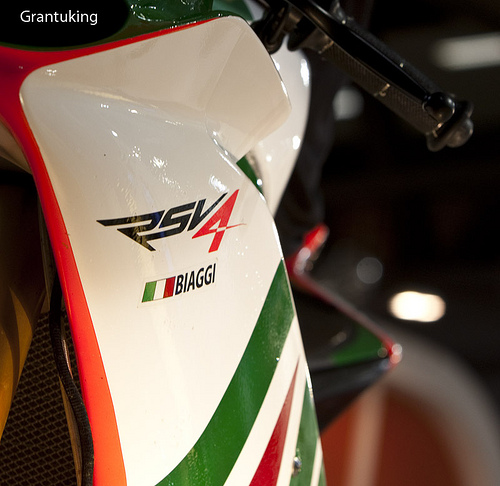
- Published in Motorcycle Review
Triumph Daytona 675R Review
Triumph Daytona 675R

A multiple Supersport Shootout winner, the refurbished Triumph Daytona 675R looks to win over test riders with its bubbly Triple and R-spec performance. Watch the result in the 2013 Triumph Daytona 675R Supersport Street video.
The Triumph Daytona 675R is no stranger to Supersport Shootout success, a three-time shootout victor since its 2006 model year debut. After some minor revamps, the 2013 model year features the first engine overhaul for the British bike’s signature Inline Triple. The R-spec 675 also sources top-shelf components and electronics, making it a more potent package than ever before.
Engineers tweaked Triumph’s 675cc Inline Triple to be more oversquare, with a 76mm bore and 49.6mm stroke (from 74mm x 52.3). Compression is bumped and the valvetrain swapped for lighter parts. The new engine ran the dyno up to the tune of 113.68 horsepower and 49 lb-ft of torque. That’s a modest 3 hp increase from the previous model and slight decrease in peak torque, but this Daytona sports a fatter torque curve in the bottom and mid-range. The 600s catch up start catching up to the Triumph on the top end, and the Kawasaki 636 actually does. But the British Triple is all about the torque down low, where it surges well above all but the Ducati and Gixxer 750.
The translation on the street is an engine with plenty of pulling power across the entire powerband. Sporting the flattest torque curve in the test, the Triumph Triple makes for a practical and playful ride.
“Power from the 675R is perfect for the street,” confirms Adey. “It has great mid-range for pulling away from traffic when needs be. And it has the top-end grunt to put a big smile on your face when the road is clear ahead for full-tuck assault.”
Brimming with street-friendly torque, the Triumph Triple is also one of the most grin-inducing engines in this class. That’s old news for anyone who’s read past shootouts with a Triumph in the mix, but in this case the British bike gets one-upped by the thrilling Triple from MV Agusta. The Italian mount sounds better on the pipe, though the Triumph isn’t far behind.
“The Triple’s engine character, with its orgasmic throaty sound and smooth power delivery, made it most enjoyable to ride,” says Adey.
“The one thing that keeps bothering me when I ride a three-cylinder Triumph is the ‘whistle’ that can cover the exhaust and engine sound,” notes a keen-earned Massimo, before allowing the Daytona mill “has character and personality.”
The Triumph drivetrain makes huge gains in 2013 with its quickshifter and slipper clutch. While the gear lever actuation isn’t quite as smooth as the Japanese rides, the Daytona’s six-speed package is both forgiving and efficient. It stands out in this test as the only bike with both a quickshifter and slipper clutch, and each one performs well.
“The slipper clutch on it specifically, man you can jam down the gears and it never chattered, never got you out of shape,” says Nathon.
Riding the well-sorted Japanese bikes, riders can be forgiven for questioning the value of a quickshifter. But the Triumph’s bang-bang immediate upshifts will have them wishing every bike was provisioned so. The shifter proves valuable on the track, but just as convenient on the street. The electronic shifter also aided during performance testing, where Adam coaxed the Daytona to a second-fastest 0-60 at 3.5 seconds. In the quarter-mile the Daytona records the third-fastest time at 11.29 seconds.
The Triumph trails only the Kawasaki in handling and braking performance, and by the slimmest of margins. And tweaks to the steering geometry, with a steeper rake, make for a sharper turning chassis.
“The 675R felt solid all the way around in the handling department,” says Adey. “Given it comes equipped with full Ohlins sus¬pension and Brembo brakes. I expected no less than what I felt – a 10 out of 10 for me.”
The Ohlins units are a fully-adjustable NIX30 fork and TTX36 shock and performance from both live up to their spec sheet billing. Where the Showa BPF units offer stability and a planted feel, the Triumph’s Ohlins suspension package goes one step further. They damp out the inconsequential white noise coming up from the road, yet transmit immediate, precise feel. And while the Triumph turns so quick that a rider expects it to twitch and lift up front, instead transitions are smooth and controlled.
The modulation and lever feel afforded by the Triumph braking package is the best of the Brembo monobloc units in this test. Only the Kawasaki’s surprising Nissin setup rates higher – and, again, by an almost imperceptible margin.
“Stopping power is immense due to its Brembo hardware. Lever feel is progressive upon initial pull, making for no-alarm braking,” says Adey, with Massimo agreeing: “Together with the Ohlins, I think it was the best combination – with effortless breaking.”
ABS comes standard aboard the 675R, the only bike to do so. The system is switchable, with three settings: On, Off and Circuit. High-performance addicts will appreciate the second setting, insisting on their superior control and unhindered stoppie/rear-slide shenanigans. The rest of us mortals will enjoy the safety cut-in, and Circuit mode allows for a generous degree of tire slip.
Ergonomics on the Triumph haven’t been the highlight of the Daytona in the past, particularly for the street. It’s still not as comfy as the 600s, but this year it did seem improved in our tester’s opinions.
“Although they gave this bike a full revamp it feels pretty similar to the old one behind the windscreen,” admits Adam. “It still feels narrow, but it’s less top heavy and the ergonomics feel more balanced and GSX-R like.”
Adey likes the riding position too, saying: “Ergos on the 675R felt like a perfect balance between go fast now… chill later.”
The Daytona’s dash showcases all the necessary info in a concise space. The prominent right-side analog tach allows for programmable shift lights – a track-oriented feature to be sure, but another indication of the 675R’s race-bike build quality. The Triumph hasn’t always felt so top-shelf.
“The Daytona 675R is a quality motorcycle, and the fit and finish appears on the same level of the Japanese machines, which is a big improvement for Triumph,” says Adam. “I also LOVE the way it looks in white.”
In the appearance rankings, only the F3 rates higher than the Daytona. This result, along with the MV stealing the Triumph’s other usual gimmie on the scoresheet, engine character, may furrow some British brows… And it is ironic that the Triumph gains so much over on the Japanese because they are boringly similar, and yet it falls short in personality to the copy-cat MV. But the raw and ragged F3 has a long ways to go before it can displace the super refined Daytona.
The Daytona eeks out another Supersport victory with its high-performance chassis and engaging personality. Triumph’s Inline Triple continues to deliver, and the rest of the component package has improved as well – a shootout winning formula.
- Published in Motorcycle Review
2013 Sportbike Comparison- BMW HP4 vs. Ducati 1199 Panigale R
BMW HP4 vs Ducati 1199 Panigale R
Even with all the HP4′s electronic rider aids, Canet couldn’t shake the kid who led the early laps of a World Superbike race at Laguna Seca in 2002.
Oh, the lifestyle of the financially affluent motorhead, the one-percenter with a passion for the finest in all things performance-related. While it’s a trend to demonize the wealthy, I say smoke ’em if you’ve got ’em, especially if that involves, say, dusting off the Bugatti with some fliers around the new Circuit of The Americas.
While most of us will never have an experience even remotely approaching that, we motorcyclists are a lucky bunch because bike manufacturers deliver amazing performance to the people. The BMW HP4 and Ducati 1199 Panigale R, the two hottest production sportbikes, are prime examples of this, so off we went to Mazda Raceway Laguna Seca for a midweek day of testing.
I felt like a lotto winner unloading the exclusive yet relatively reasonably priced HP4 out of CW’s high-mileage Chevy van. Then the scene ramped up an entire tax bracket when the guys from Ducati North America dropped off the much pricier and more exclusive Panigale R. With this wealth of exotic hardware at my disposal, the charitable thing to do was share this ultimate track-day experience with another in need of speed.
Who better than Eric Bostrom? Not only does the retired professional Superbike racer and former AMA Supersport champ have an extensive racing resume, he also possesses riding gear with CW logos! EBoz, as fans know him, is a Northern California native who intimately knows the 11-turn, 2.23-mile circuit nestled in the hills east of Monterey Bay. Although he’s had multiple great performances at the track, he considers his win aboard a factory Ducati 999 in the 2005 AMA Superbike National the most memorable.
Both bikes wore their stock-fitment Pirelli Diablo Supercorsa SP tires, although the Duc’s are Type 2s, the newest version of this superb, track-day-focused radial. The morning began with a crash course in electronics 101 as a Ducati representative explained how to navigate the setup menus displayed on the TFT dash display. With the Beemer, I was on my own. Only after messing up the clock setting did I figure out how to access the important stuff. Although frustrating at first, I quickly gained command of toggling through each bike’s myriad setup options. This allowed EBoz to wholly focus on knocking out comparative lap times.
Laguna operates under stringent noise regulations to appease its neighbors in the surrounding hills. Even stock bikes, such as the Yamaha Champions Riding School’s muffled YZF-R6s, are too loud for the sound monitor located between Turns 5 and 6, so a chicane is created at that point with cones to slow and quiet the bikes there.
For the record, the HP4 has an Akrapovic titanium exhaust with a large-diameter, straight-through muffler core! Perhaps its saving grace would be the catalyst in the tailpipe keeping decibels in check? While the purchase of a Panigale R includes a Termignoni race exhaust as part of the spares package, we ran the relatively “quieter” stock system at Laguna, before changing to the race exhaust and mapping for dyno and dragstrip testing. With risk of a black flag and banishment from further riding in mind, we were relegated to pulling in the clutch and coasting past the sound shack before resuming the charge under the bridge leading to Turn 6. Eric did his best to be consistent with this during timed hot laps and knocked out a best lap of 1:33.07 on the Panigale and was only .02 seconds off that pace on the BMW!
Arriving at those lap times was good fun, as we spent the morning comparing impressions and tweaking the setup of each bike to Bostrom’s liking. It’s amazing that this was all accomplished without a single tool; altering the suspension damping on either bike is accomplished electronically, and spring preload for both shocks is changed via conventional twist knob. While damping changes made to the Ducati’s shock and fork are static in nature (that is, not actively changing in response to how you ride), our HP4 featured fully active Dynamic Damping Control in the rear and static adjustment up front. Although the BMW’s fork is DDC-ready, an accessory suspension-travel sensor must be added to unlock that feature.
While the Panigale R exudes a hard- edged, race-focused demeanor from the moment you pull onto pit lane, the HP4 proved quite the opposite. Its comparatively relaxed riding position, softer seat pad, initially plush rear damping (thanks to DDC) and “heated grips” lull you in, right up until you unleash its 186 rear-wheel horsepower! Bostrom handed the BMW off to me following our first session, with a warning to be on the lookout for some front shimmy cresting Turn 1, a left bend on the front straight that’s taken flat-out. I added a couple clicks of steering-damper adjustment and held my breath. The climb up the steep hill to the Corkscrew saw the front tire skimming the road surface with a hint of wiggle much of the way, as well. Bostrom suggested firming the rear to deliver a more planted front-end feel. We ultimately settled on adding two full turns of shock preload along with +3 increments of compression and +2 rebound damping, which resulted in better feedback and weight-transfer control.
Although the Ducati’s setup was closer as delivered, Bostrom needed more time aboard the demanding Duc. His primary concern was a tail-wagging tendency under hard braking, which resulted in a top-heaviness at turn-in and an unsettled feeling that lasted down to the apex of the corner. We programmed the Race and Sport ride modes with slightly different suspension damping parameters, allowing on-the-fly comparison of setups. While a modest improvement in overall handling and stability was achieved, the loose, tail-happy feeling persisted. The cure turned out to be right under our left thumb. Simply toggling the Engine Braking Control to its most free-wheeling setting netted nearly a full second off Bostrom’s previous best lap.
Putting this into perspective, Bostrom felt both bikes were capable of breaking into the 1:29s on an unadulterated lap. He further speculated that swapping the stock tires for full race-spec rubber would enable him to match the times that carried him to victory aboard the Parts Unlimited Ducati 999 back in 2005. How’s that for progress?!
For me, this was an ultimate track-day experience with a racer I’ve long admired. Talking in the pit garage as Mr. Kuhn shot static and detail photos in the late-day light, Bostrom and I marveled over the amazing performance of these two bikes. What amazed us most is just how accessible high performance has become through the advancement of electronics.
While both bikes feature anti-lock brakes, Bostrom prefers toggling the BMW’s ABS off for track use, citing a spongy lever when the system cycles. Neither of us were able to detect any hint of intervention when the Ducati’s ABS was on and set for circuit use. And the traction control on both bikes had these two old-school racers shaking our heads in disbelief at how quickly such electronics have changed the riding landscape. Bostrom even asserted that anybody with a hint of ability can ride either of these bikes at a surprisingly quick pace. And yes, he was looking right at me when he said that!
For a working-class stiff such as myself, a day spent living large at Laguna was the stuff of dreams as I chased a roadracing hero and painted darkies off any corner I wanted, thanks to total digital control. EBoz is right: Not so long ago, no amount of money could buy the experience these bikes deliver.
Which is just one reason arguing for a winner here is so difficult. These are both such satisfying yet different motorcycles, but the Panigale R has an explosive edge to it that almost makes it feel like a twin-cylinder MotoGP bike.
- Published in Motorcycle Review
MV Agusta F3 800 Review
MV Agusta F3 800 Review
Inspired by MV Agusta’s legendary 500cc and 350cc grand prix racing bikes that Giacomo Agostini rode to 14 of his 15 world titles, the new F3 800 Triple is the brainchild of the late Claudio Castiglioni and former designer Massimo Tamburini. Their goal with the F3 and Brutale families was to develop a platform that expanded market share and shared major components, thus reducing production costs and increasing profitability.
Powering the 800 is a compact three-cylinder engine with a cylinder head that’s identical to the 675’s. The crankshaft, however, has been stroked from 45.9 to 54.3mm, which, together with the unchanged 79.0mm bore, results in a displacement of 798cc. To make this possible with a common cylinder head and crankcase, the connecting rods had to be shortened from 109.3 to 105.1mm. The compression ratio in the already compact combustion chamber has increased from 13.0:1 to 13.3:1.
Both engines share the same camshafts and trio of 50mm, dual-injector throttle bodies, but the 800’s upper injectors flow 15 percent more fuel, helping the larger motor produce a claimed 148 horsepower at 13,000 rpm and 65 foot-pounds of peak torque at 10,600 rpm. A six-speed, cassette-type gearbox and a slipper clutch transmit power to the rear wheel.
Managing power is MV’s MVICS throttle-by-wire electronics suite, which is integrated into the F3 800’s EM2.0 ECU. Included are four maps (Sport, Rain, Normal and Custom), and eight-level traction control. What’s more, the bike has a wealth of other adjustability, with settings that allow the rider to set tip-in throttle response, max torque (Sport or Rain), engine braking (Sport or Normal), engine response (Fast or Slow), engine torque (Sport or Rain) and rpm limit (Sport or Normal). The F800 also offers wheelie control and an optional quickshifter
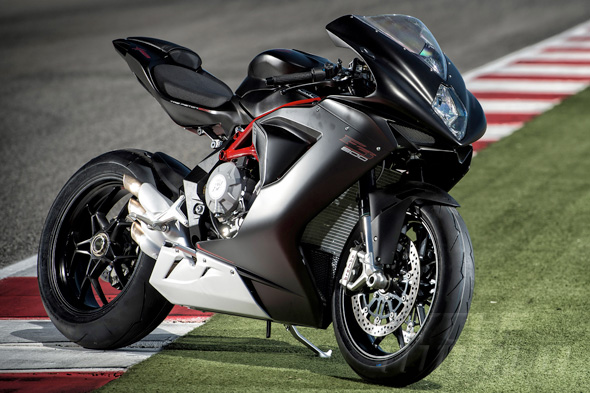 Metallic Matt Black
Metallic Matt Black
 Red-Silver
Red-Silver
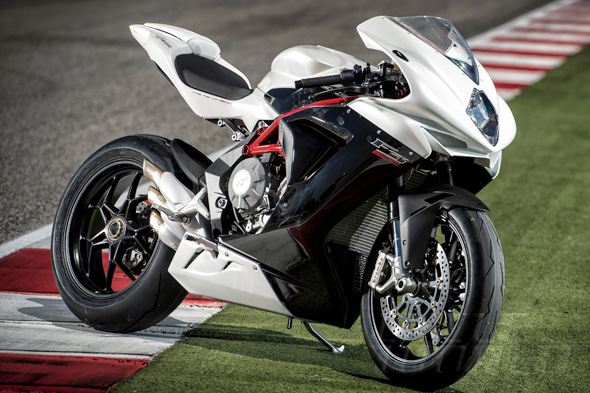 Pearl White/Black
Pearl White/Black
Key to the F3 800’s performance is the fact that it shares a chassis with the 675, much like Suzuki’s GSX-R600 and GSX-R750 have a common platform. As such, the F800, with a claimed dry weight of 381 pounds and a 20-hp bump in peak in power (compared to the 675), has a pretty sweet power-to-weight ratio.
Chassis highlights include a 43mm inverted Marzocchi fork and a Sachs shock, both of which are fully adjustable. Radial-mount, four-piston monobloc Brembo front calipers with 320mm discs and a twin-piston/220mm disc setup out back handle braking duties.
Riding the F3 800 at Italy’s Misano World Circuit, I was impressed by the MV’s precise steering and stable chassis through the track’s esses, which get progressively tighter before feeding into the Turn 14 hairpin. Exiting Misano’s multiple hairpins, the 800 felt like it was shot out of a slingshot. Despite a relatively short front straight, the F3’s LCD dash would register an indicated 130 mph prior to braking for Turn 1. The Brembo brakes performed excellently, while the chassis itself remained composed under hard braking
Complaints are few, but I have to mention a lack of fuel-mapping refinement at small throttle openings, especially when feeding in mixture mid-corner. Additionally, a touch more engine vibration is noticeable than with the 675, due to what I feel is the 800’s higher revs and a secondary imbalance attributed to the different crank and rods.
Despite this, the new 2014 MV Agusta F3 800 is one of the most potent machines available in the middleweight sportbike class. With a little refinement, it could be a real contender.
Do you own an F3? check out our fantastic carbon & performance parts.
- Published in Motorcycle Review






